Josh Turner
Josh Turner is the WSJ best-selling author of Connect and Booked, and the Founder and CEO of LinkedSelling, a B2B marketing firm specializing in fully outsourced LinkedIn lead generation campaigns. He is considered one of the leading experts in the world when it comes to growing your business using LinkedIn, representing clients like Neil Patel and Microsoft.
When I talked to Russ Henneberry a couple months ago he said, “I like your idea for the session. When you come here, you’ve got to make sure that you’re giving people value. No, like, thinly veiled sales pitches, etc.” I told him, “I’m just gonna come show everybody the entire system that my company uses that our clients hire us for to get high ticket leads and clients off of LinkedIn.”
The kinds of people that hire us are the people that are looking for five, six, seven figure engagements, and it takes a different approach when you’re using LinkedIn and to get through to a lot of these types of decision makers.
Who would be interested in a two-step process, iron clad, foolproof way to get 99% of the people you reach out to on LinkedIn to never want to talk to you again?
The first step is you connect. Send a connection request. The second step is
you pitch. It works every time…. No one will ever respond to you. These are the kinds of messages that we all get from time to time.
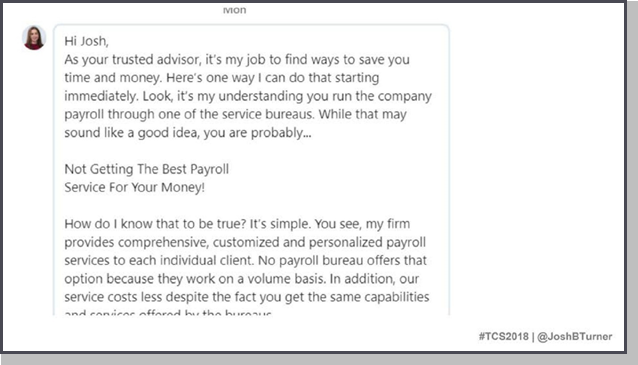
Here’s one that I got a week or two ago from somebody who runs a payroll company, and her heart’s in the right place. She wants to be my trusted advisor, which I appreciate, but this kind of stuff nobody ever responds to it. IT companies and lead generation companies are probably the worst at this. Maybe it’s just me, but I get pitches like this on a regular basis from people that either want to build me a website or help me plug my computer in. This stuff, it really doesn’t work. It’s really what gives LinkedIn a bad name, in my mind. A lot of people feel like, if this is what LinkedIn’s about, I don’t want to do it. Our approach and the systems that I’m going to be sharing with you guys today is the complete opposite of that. In all seriousness, I am going to be showing you guys the entire playbook, including messaging scripts and templates and all that stuff. These are the things that we do for our clients.
When I started my company, I realized that the things that most people were saying to do were not working for me. Blogging and all the posting on Facebook and all the stuff that people would say you should do just didn’t get me any results. Going to networking meetings, coffees, lunches, didn’t get me any results.
I turned to LinkedIn because I realized that if I want to get high-end clients, I need to design a process to go out and get to the exact right people.
I’m not going to bore you with some of the stats, but there’s a shit load of people on LinkedIn who could be your client. You guys are probably all sitting
here because at one time or another, you’ve gone on LinkedIn and looked and said, “Wow, there’s a lot of people on here that could be great clients of mine. How am I gonna tap into this?” This is why I decided to go into
LinkedIn, too, because there’s really nowhere else like it online where you can hand select the exact people that you want to do business with. That’s what I realized at the time. There’s this place called LinkedIn that’s like a trade show like this where every single person there is your ideal prospect, and if you know how to position yourself right, it’s an asset that can generate massive results for you.
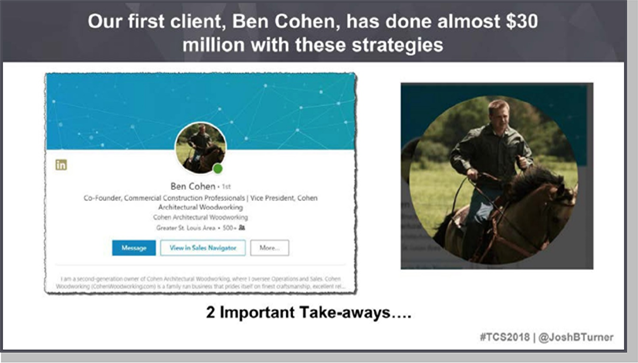
This is my first client. He was actually, at first, a company out of St. Louis that hired me to be their outsourced CFO, so essentially I helped them with spreadsheets. What Ben Cohen hired me for is to implement the system I’m showing you today. I was using it in my business and a couple of my clients, Ben included, said, “Hey, Josh, this thing you’re doing on LinkedIn, would this work for me?” At the time, I actually looked around. I said, “Maybe I can find another company out there that can do this for you,” but all I could
find were social media consultants and gurus that didn’t actually know to use LinkedIn the right way, to actually go out and get connected to prospects, build relationships with them, nurture those relationships, and convert those into bonafide sales appointments, so I said, “All right, Ben. I’ll do it for you.” That first client of ours, he’s done nearly 30 million in sales since 2012.
Two takeaways from this. This is the exact message, part of a multi-message campaign, that we used for Ben to get a client that’s been worth many, many, many seven figures for him.
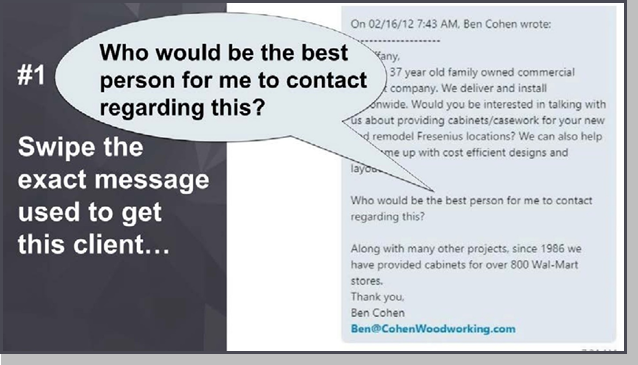
This is a message that works pretty well because if you’re going after corporate type people, instead of saying, “Hey Tiffany, this is what I do. Would you be interested in talking to me,” you use this. We call this the appropriate person strategy. Some of you have probably used this yourself or heard of it, where you just say, “Who’s the best person for me to contact regarding this?” You’re not really pitching anything. You’re just saying, “Who’s the right person?” It’s much easier for Tiffany to then say, “Oh, it’s Kirk in my office,” because Tiffany doesn’t want to talk to you, but she’s happy to pawn you off on Kirk. This can work really well in a corporate setting.
The second thing you gotta do is use a picture of yourself on a horse. Most of you, I don’t know, most of you probably don’t want it bad enough to use a picture of yourself on a horse, but as you can see from Ben here, it was because of that horse picture that he’s gotten these kinds of results, but in all seriousness, it was this first client that we worked with that really allowed me to see that we’ve got a system here that could probably work for a lot of other businesses. Since taking on that first client, which was in late 2011, we’ve gone on to do some pretty cool things in our company.
For those of you that don’t know me, my company’s called LinkedSelling, I’m the founder and CEO. We’ve got a team of about 45, most of them in St. Louis. We also have a small office in Pennsylvania. We’ve been on the Inc. 500 a couple of years in a row. I wrote a Wall Street Journal Bestseller called Connect, another one called Booked, and what my company does is we help people implement the system that I’m going to be showing you today. Some companies hire us to do it all for them, some people join our training programs and implement it for themselves. That’s what we do, and
this three-step system that I’m going to be walking you through today is what we have built over these years, and it’s called Create, Build, Connect. Within each of those, there’s some moving parts. I’m going to walk you through all of it. Essentially, at the end of the day, what it does is allows you to go on LinkedIn, target the exact prospect that you want to be working with, work them through this system, and get on average 21% of them to agree to a consultation or a sales appointment.
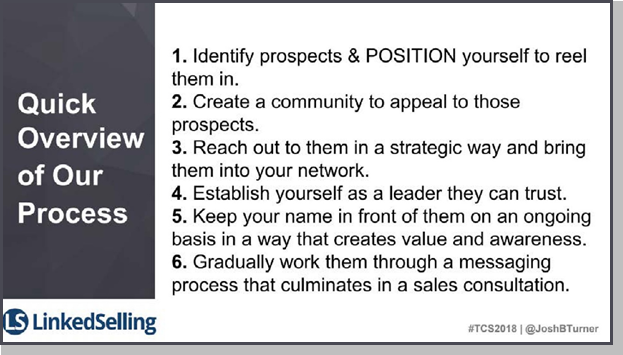
Quick overview of what we’re going to walk through today. I’m going to be showing you how to:
- Identify prospects and position yourself to reel them in
- How to create a community that’s going to appeal to those people and be a place that they actually look forward to getting information from, but takes you very little time to execute and implement
- How to then use that positioning to reach out to your prospects in a really strategic way and get connected to lots of them, how to then, on an ongoing basis
- Establish yourself as a leader that they can trust
- How to create a lot of top of mind awareness and a lot of value, so that when you start working them through the messaging process that I’m going to show you, that they’re very open to having a conversation.
With that, I talked about trust. The thing that I set out to do when I first started doing this LinkedIn stuff was figure out how can I build a mousetrap that doesn’t cost me any money that I can just do myself and get connected with these people that have never heard of me before, don’t have any clue who I am, and somehow design some sort of a campaign or process that will culminate in me getting in front of them and getting an at bat. We call it systematically building relationships because when you take the positioning that we create with this system, and work people through this process, by the time you make the invite for the consultation, for the strategy session, whatever you want to call it in your business, people are very receptive and open to it. Again, the three-step system, Create, Build, Connect.
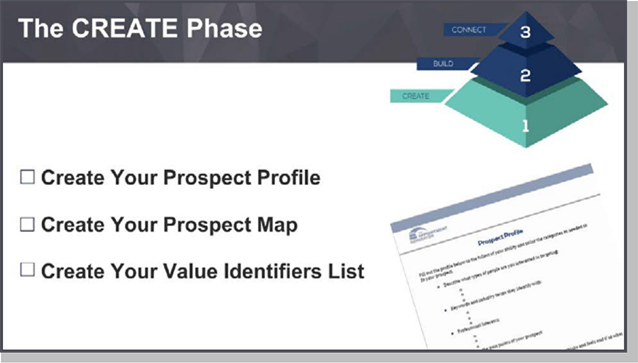
I want to dive into create first. This is where you really create the foundation
of what you need to have the information and the intelligence to build the
rest of it out. Essentially what this is, is getting clarity on who your ideal prospect is. One of the things that we often talk to our clients about isn’t just, “Tell us who your avatar is,” but also, “Let’s look at your existing client base and what’s the 80/20? Who are the people that are really the ones that you would love to get more of, and what can we do to get more people like that?” That’s the prospect profile.
From there, create your prospect map, which is essentially, “where can we find them on LinkedIn? Where can they be reached?” Obviously, using the advanced people search is an easy way to find people, but you also want to figure out what groups they’re already hanging out in. That’s a really great way to get intelligence on them to drive your value identifiers. Value identifiers is part of this initial create phase of the system and what this is all about is really understanding what makes your prospects tick. What keeps them up at night? What do they care about? What kinds of things are they
interested in? We then use this to determine what kind of content we want to use in the campaign.
This is kind of a mindset shift for a lot of people that we work with, where we say, we actually tell our clients, “We don’t care if you have any of your own content. We don’t need it. If you have some that you want us to work into the campaign, great, we can do that, but what we want to do is go find the best of the best stuff that’s out on the internet and share that stuff with your prospects so that they see you as somebody that’s constantly showing up and creating value. Side benefit to that is that you don’t have to create any content and you’re always showing up and giving value and there’s really efficient ways to drift that stuff out. We’re going to do it within a LinkedIn group and I’m going to show you our strategy for that. We’re going to do it via status updates and through messaging campaigns.”
They see all this good stuff that they actually care about, which, again, it’s a mindset shift. A lot of people are just so focused on telling my story and
sharing content about what I do, but for a lot of us, your prospects don’t care that much about what you do. They care about themselves. If you can figure out what they actually care about, and show up in that way, it really helps you build a real relationship with them where you’re somebody that they actually look forward to hearing from.
With that, you have this foundation of knowing who your prospects are, where they can be found, what they care about, and what keeps them up at night. But, you still have to find a way to separate from the pack and stand out because there’s a lot of noise out there.
What we’ve found is that if you can find a way to systematically position yourself as an authority and a leader and a peer to them, that’s what gets you in the door and enables the system to work.

The way we do that is step two of the system, something we call Your Authority Leadership Platform. A Harvard study conducted on two different groups of students where a lecturer said to one group, “Here’s a professor who gonna tell you about X, Y, and Z.” Then he went to the other group of students, “Here’s a dishwasher who’s gonna tell you about the same exact content.” To nobody’s surprise, the students found that they responded more strongly to the professor than the dishwasher. The concept applies to our businesses as well. Are you the professor in this example or the dishwasher of your industry? Of course, we all know and realize that we’ve got something great in our businesses, which is telling people about your products and services and features and benefits. All of your competitors are doing the same thing. I’m not trying to be derogatory because I know that some of
my prospects view my business this way, where they look at us like the dishwasher if we don’t have a way to stand out.
The way we do that through this Authority Leadership Platform concept is we create a LinkedIn group. We call it Authority Leadership Platform because,
if I called it LinkedIn group, that wouldn’t sound as sexy. Really, what we are doing is positioning you to have authority and to be seen as a leader in your market and a peer in your market. I’m going to show you a couple examples of how this works. I think you’ll get it pretty quickly.
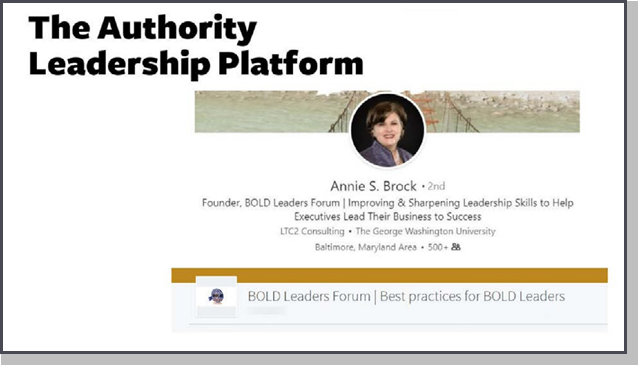
Annie Brock, she’s a leadership coach. Because she’s the founder of Bold Leaders Forum, when she reaches out to leaders in executive roles and such, they’re more open to connecting with her than if her headline said, “Leadership Coach.”
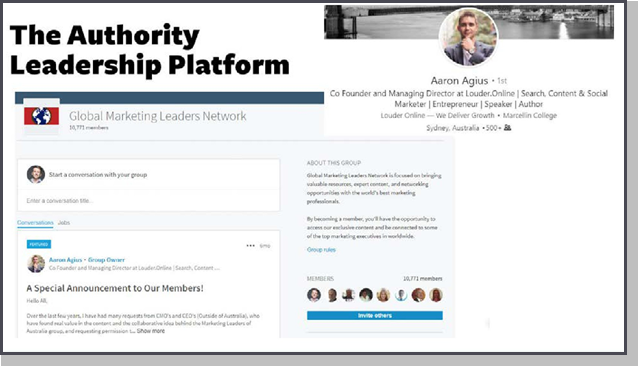
Another example, Aaron Ages, one of our clients, he’s out of Australia. As the founder of Global Marketing Leaders Network, when he reaches out to high level marketing executives, it’s just statistically proven that they’re more likely to connect with him than when they see, “Great, here’s another guy running a marketing agency that’s reaching out to get connected with me.”
You may be thinking right now, “boy, this is a big emphasis on these LinkedIn groups. I don’t know if anyone even goes to LinkedIn groups anymore.” But, LinkedIn has announced recently that they’re reinventing into groups. Post the Microsoft acquisition, it looks like they’re putting more of an emphasis on making groups a good thing again that people will actually use and consume and engage in.
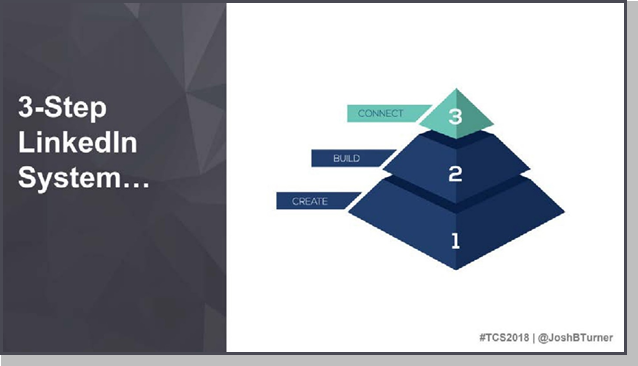
Once you’ve created the positioning, built your Authority Leadership Platform, now it’s time to start getting connected to people. This is a question I get a lot. “Do I build the group before I get connected with people?” Yes. If you’re implementing this methodology, you want to create your group, your community, before you start getting connected with people. The reason is so that then, when you reach out, they see that you’re the founder of XYZ.
From there, we start what we call the Database Build Process, and this is where we leverage all that positioning to get connected to thousands of potential clients. There’s a couple ways to go about it. A lot of people ask me, “What about the Sales Navigator? Should I be buying a premium account?”
If you’re implementing this yourself, one of the things you can do is get a free Sales Navigator trial for 30 days and go hog wild, build your database, take advantage of a lot of the advance search functionality it offers, and then cancel it. The main point is that there’s just a million ways that you can target people on LinkedIn, and you guys have used the advanced people search before and poked around it and seen some of the functionality it offers, I’m sure.
There’s tons of people on LinkedIn. Every time I sit down with a potential client or a client and look at how many people are there out there for us to go after, we always end up with this big number that’s too many people
to realistically be able to reach with this kind of a process, because within LinkedIn, there’s a limit to what you can do. You can’t send 1,000 connection requests a day. There’s limits to this kind of stuff, because you really have to work within the confines of what a normal person would use LinkedIn for.
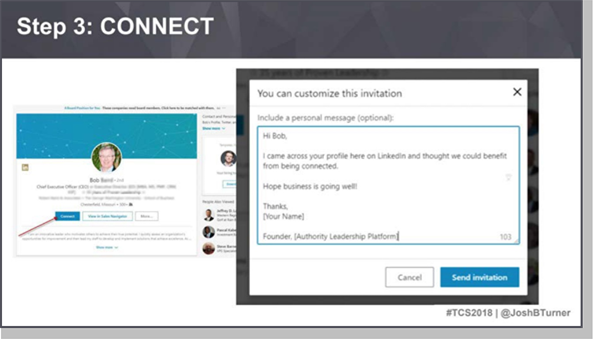
When you’re connecting with people, once you’ve already connected to Kim Jong-un, the next person is Bob, and Bob is so high level, we had to blur out his last name, but this is the kind of connection request script that we typically recommend as a starting point for most of our clients, and it just says, “Hey, Bob, I came across your profile here on LinkedIn. I thought we could benefit from being connected. Hope business is going well.” You can see how in this little signature there, we say, “Founder,” and then insert the name of your Authority Leadership Platform.
We’ll see typically, on average, about 40% of people that we reach out to with this message will agree to connect. You might be thinking, “Whoa, when I reach out to people, I can get like 80% to agree,” or whatever it might be, and there are ways to customize every single outreach you do and spend lots of time writing personalized messages to reach out to people that can get a higher hit rate than 40%. When I’m trying to create a system that I can send lots of connection requests to people in a short amount of time so that we’re not spending all week long sending connection requests because when you see the math, we need to send a decent amount to build up our database to the right level.
Once we connect, how many of these do we need to get? Well, if you want 60 appointments, if you just think about the math, if 21% of the people that you get connected to are going to move to the consultation, and if you want to get 60 appointments, then you really end up having to have 300-400 new connections per month. Why did I give you the raise? Because 21% is an average. If you want to be conservative and say, “Well, let’s say I only get 15%,” then it would be about 400 new connections that you need to get.
Most of our clients don’t start with 60 appointments per month, because you want to get it dialed in. I think a better place to start for most people with this system is, how do we get 10-15 appointments per month? Then once you get that process dialed in, that’s when you want to start ramping it up. There’s nothing worse than doing a shit load of work and then having something not actually paying out for you. It’s very defeating, at least for me, so we always recommend that people start smaller, get it dialed in, and then ramp up from there.
What’s the difference between initial outreach and month number one? That’s when we do the initial database build process. What we recommend people do to really come out with a bang and to really get this thing moving is to reach out to typically around 1,500 prospects in the first month so that you build a really good database that you can launch your group with. That’s really key. You don’t want to have a group that’s got three people in it. In
the first month, we want to reach out to a lot of people and build a really big database, which is really exciting because after just a couple weeks and you’re like, “Wow, now, all of the sudden, I’ve got 5, 700, 1,000 new connections on LinkedIn that are like the exact people I wanna work with.”
It’s pretty exciting. Then on an ongoing basis, we keep doing the monthly outreach to keep bringing enough new people in to work them through the messaging campaigns.
What it takes is a proactive process where you’re reaching out to people, working them through campaigns that drive them into a consultation. This is a process that we have really been refining, and I’m going to show you a couple different versions of the playbook. I’m going to walk you through some messages for it.
Twenty-one percent of the people work through this process on average, will
agree to a phone call. Some of our clients end up higher than that, some less,
but it makes it really easy to know, “Hey, if I want this many appointments, here’s how many people each month I need to work through,” and you can just manage that cadence, and you have batches of people getting worked through these messaging campaigns at different stages.
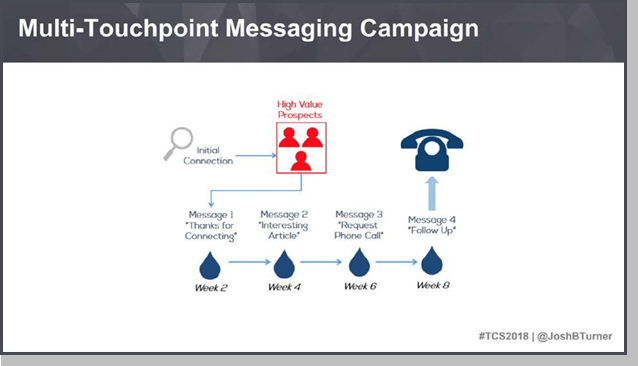
This would be a four-message campaign where. That would be the minimum of what you would want to do. Some of our clients will have a seven-message campaign, and these messages would all be sent from within LinkedIn. One of the reasons it works is that they’re seeing your stuff all over the place.
You’re showing up in a way that positions you as a peer and a leader in their industry. The other thing is that people’s LinkedIn inboxes are just not nearly as crowded as their email.
Let’s talk about these messages. I’m going to show you the four messages that would be in the minimum kind of playbook that you would want to roll out, and then I’m going to talk about some of the options for how you can automate it if you want to do that. I’ll tell you the pros and cons of that.
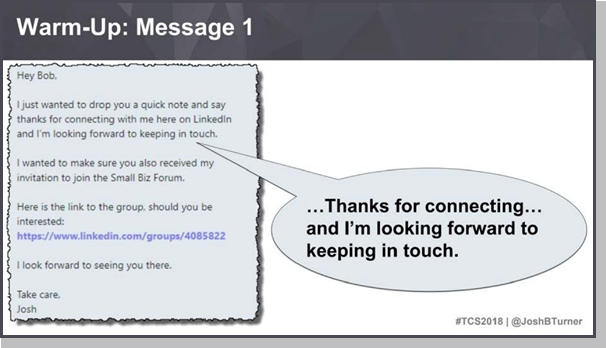
This is the first message, where I say, “Hey, thanks for connecting. Looking forward to keeping in touch.” That’s really the gist of it. In this case, there’s also a link to drive people into the group, to try and grow the membership there and keep people aware of that, as well, but, really, it’s just you connect with someone and you just say, “Hey, looking forward to keeping in touch.” That’s pretty much the gist of that.
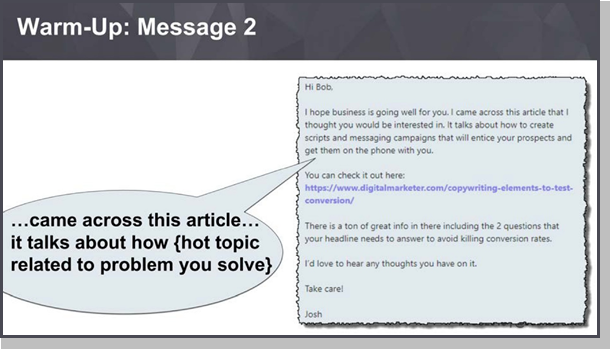
Message two is just sharing some content with them. This is creating more top of mind awareness, creating another touchpoint, and trying to show up in a way that you’re adding value while also seating the problem that you solve in their minds so that they start thinking about what you do a little bit. You kind of have to be strategic about how you do it so that you’re not seen as just pitching them on your stuff right away, which is why we like to use third party resources to do this instead of your own blog posts or your own case studies, so that it feels more like you’re just sharing some good stuff with them. There’s a lot of ways to position these things and to massage these messages for your own situation.
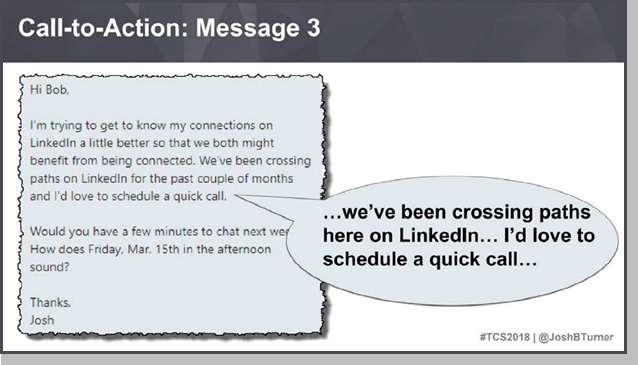
What we would do in message three then is invite them to the phone call. You see, by this point, they’ve seen so much of your stuff, so many messages
… Well, they’ve received two direct messages prior to this. They’ve seen so many posts in your group that they’re just really open to connecting. At
the end of the day, there’s a bunch of reasons why I think this works so well. 7-12% of people that receive this message will typically say, “Yeah, let’s jump on a call,” and there’s a lot of ways you can position this to either be more direct with the message or to be less direct and make it more about, “Let’s have a networking call,” or, “Hey, this is exactly what I wanna talk to you about.”
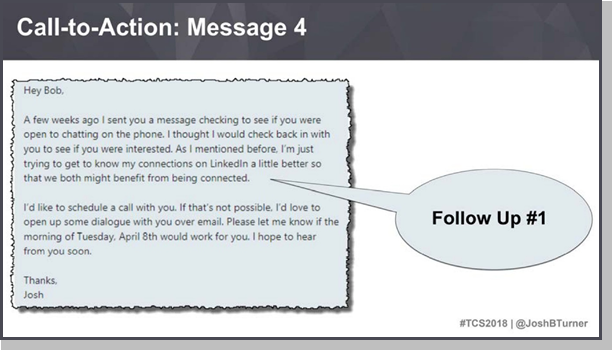
The fourth message is the follow up, and this is key. I’m going to talk a lot about follow up and show you some different ways to do that, but in this message, it’s very simple. It’s just, “Hey, I hope you got my message a couple weeks ago. I just wanted to follow up and see if you’d still be interested in having a conversation.” Again, you really have to make these messages for your own situation.
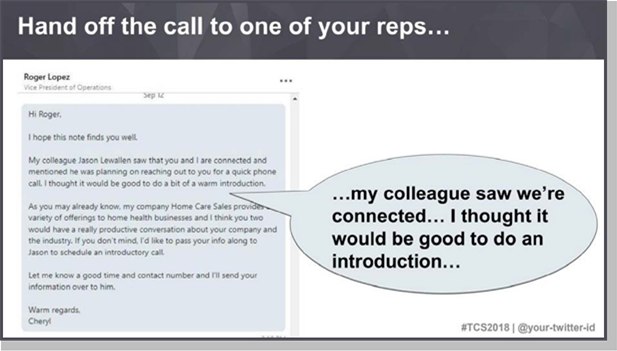
One of the things you can do is hand off the call to one of your reps if
you don’t want to be the one that actually takes the call yourself. Use a message like the one above. You might say, “Well, why wouldn’t I just have my reps doing all this stuff and then doing it on their own? Why would I even be involved in where I need to hand it off?” Well, for our clients, they do this because they’re building an asset. This isn’t a one and done lead generation thing, like if you hire some appointment setting company to do
telemarketing. This is building an asset that you’ll be able to utilize long-term.
You really don’t want a sales rep to invest in building this for them within their LinkedIn account and have them leave your company. For a lot of our clients, they build it all out within the CEO or another leader or owner of the company’s account, and then they hand off the call at this point to one of their reps. It’s very simple, and it actually gets just as good of results as if you’re the one taking the call.
You can see here kind of how it works. You just say, “Hey, so and so in my office saw that we’re connected and mentioned he had planned on reaching out to you. I thought it would be good to do a bit of an introduction. So and so works with these kinds of clients, similar to yours. I think you guys would have a productive conversation.” This is great, again, for folks that are going after corporate, as well, works really good, but it can also work in coaching and all sorts of different markets.

Here’s another playbook that, in some ways, flies against some of the things
that we teach. What I wanted to share with you guys in full transparency to say, “This is something that has been working with some of our clients recently.” The moral of the story here is that it really depends. You have to test different things.
You can see that there’s a lot of follow ups there, follow up requests, follow up to the follow up, two email follow ups, and there’s a reason for that. The more follow up messages you send, the more success you’ll likely see.
Follow up is a huge part of the overall system, but a lot of our clients don’t even do the email stuff. I say, “You gotta do the email stuff,” but a lot of people just don’t do it because they don’t want to or they’re getting good enough results for LinkedIn.
Overview
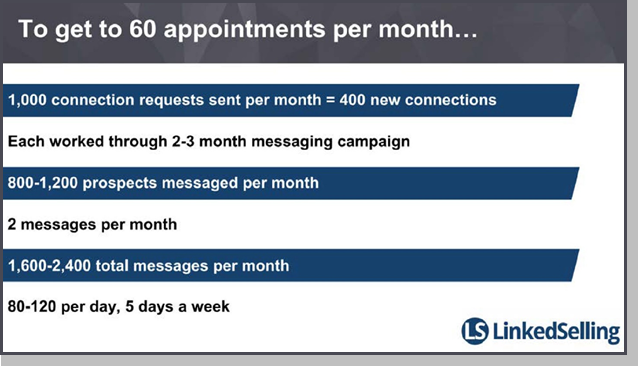
To get to 60 appointments per month, remember, we need 400 new connections. Each of them are going to get worked through a two to three- month messaging campaign, ideally, and we’re going to be then sending to 800-1,200 prospects, getting a message each month, so 400 connections, a two to three-month messaging campaign. They’re each getting two messages
per month, which means that you got to send 1,600-2,400 total messages per month, which breaks down to 80-120 per day, five days a week, to implement this system. You go, “That sounds like a lot of messages. I thought it was like 21% and da, da, da,” but it’s a multi-message campaign that you’re working people through.
Seeing this, most people will say, “Well, I’m gonna start out a little smaller than that and get things dialed in,” like I talked about. For 15 appointments a month, the same math breaks down to a more feasible number of messages sent per day and new connections that you have to send on a monthly basis. It’s a numbers game, just like any marketing at the end of the day, and it’s about how you’re getting connected with people, but doing it in a way where you’re not churning and burning people and in a way where you’re building value and you’re not just overtly pitching people, because if you’re in this room, you’re in this room because you’re looking for more high ticket clients, and you don’t want to be churning and burning people and creating kind
of a bad reputation in your market or whatever it might be because these relationships are worth a ton over time and it’s worth investing in the long game to do it the right way.
With that, the quick overview of the process is:
- Build the foundation – know who your clients are and what makes them
tick
- Use that information to build your Authority Leadership Platform
- Once you have that in place, do the database build process. Start getting connected to tons of people. Work them through the messaging campaigns.
At the end of the day for you to consider if this is something worth doing
is to think about the math and the ROI. If you have 15 new high ticket appointments each month, be conservative about your close rate, how many of them will end up moving forward with you over time, and extrapolate that over a year, two, three years. For the folks that we work with, the number is so significant and staggering of what you can achieve with this that it’s a no- brainer to put this system in place.
- Connect: The Secret Linkedin Playbook to Generate Leads, Build Relationships, and Dramatically Increase Your Sales by Josh Turner
- Booked: The Digital Marketing and Social Media Appointment Setting System for Anyone Looking for a Steady Stream of Leads, Appointments, and New Clients by Josh Turner
- www.LinkedSelling.com
